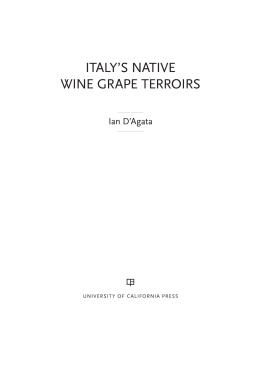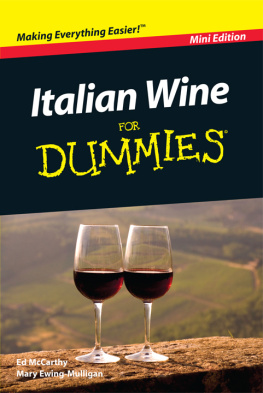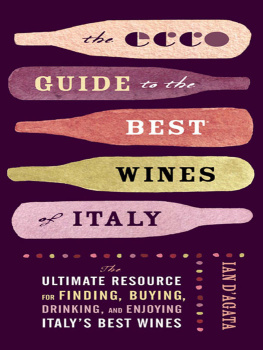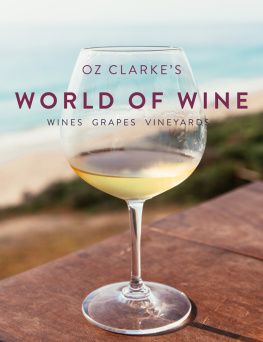PREFACE
I hold a deep-rooted passion for the native grapes and wines of Italy. Though I am also a great fan of Riesling, Pinot Nero, Merlot, and proper Cabernet Franc (how can any wine lover not be?), it is wines made with Italys native grapes I would want with me if banished to a desert island (given that Gwyneth Paltrow is already taken).
I have always been fascinated by the rich diversity of Italys innumerable grape varieties. In 2001 I wrote the first series of detailed articles on a number of Italys native grapes for Porthos, then a mainstream Italian wine magazine. I followed this up by doing the same for the Gambero Rosso magazine in 2002 and 2003, which led to the publication that year of the first guidebook ever specifically devoted to Italian native grapes and wines. Every time I catch up with Marco Sabellico, currently the elder curator of Gambero Rosso s annual wine guide, our memories invariably drift back to what at the time seemed like an infinite string of late summer nights, a desperate and ultimately successful attempt at meeting our deadline. Whereas as recently as 2000 practically nobody in Italy ever wrote of wines in terms of native and international grapes, there are now myriad books and websites devoted to these subjects.
I now write about the worlds many wonderful wines for Stephen Tanzer and his prestigious International Wine Cellar, and more recently, for the British wine magazine Decanter. However, I still champion native grapes and wines, and the people who have devoted their lives to them. I am enthralled with native grapes, each ones long-standing relationship with its local geology and climate, and how each one is expressed in unique wines. An added plus is the cultural bond these grapes have established with local people, territories, and traditions. Unfortunately, when I started out, little was known about these grapes and virtually nothing was being written about them; worse still, many were at risk of extinction. Given my love for drawing and my medical background (including a couple of years of bench research, spent doing western blots and learning polymerase chain reaction tests, the latter a technique also used for grapevine identification), I was naturally attracted to ampelology, the science that studies and identifies grape varieties. Over the years, I always paid more attention to the grapes people were using, and obsessed a great deal less than most about, for example, the type of oak or yeasts they used. Already then, I believed that understanding single grape varieties (as well as the relationships that different varieties have with each other) inevitably leads to a better understanding of the wines made from those varieties. Still today, I feel the need to broadcast and promote the as yet untapped potential of native grapes and wines: and not just Italys, for that matter.
The book you hold in your hands is the summa of close to thirty years spent in the company of wine, and more pertinently, thirteen years of research, vineyard walks, and interviews especially devoted to the native grapes and wines of Italy. It is intended as both an academic text and a practical guide to the rich grape biodiversity that is Italy-and not just to the rich and famous jet set of Sangiovese or Nebbiolo, but also to Bellone, Centesimino, Rossese di Dolceacqua, and many others. This book is not for those who cannot manage without one-hundred-point scores, inky-black hues, sexy smokiness, mouthcoating concentration, and all the rest of it. It will be appreciated even less by those who regard native grapes as a marketing ploy at best, or a nuisance at worst. No, this book is for all who realize that wine is not a soft drink, industrially made and replicable ad nauseam independently of its ties to the land, the history, the social context, and the people who live and make it. Most of all, it is for those who understand that wine cannot and should not be viewed independently of the grape varieties used to make it.
It is not my intention to give the impression that native grapes are better than international ones, or that traditionally made wines are more interesting than those made with an eye to modern tastes. There is no right or wrong way to enjoy wine, and each one of us will appreciate the aspect of wine that intrigues us most. Wine allows all of us to learn about new people and places, and I have always found that Italys native grapes are a great way to gain a deeper understanding and appreciation of the sometimes crazy but always wonderful country that Italy is. Wine is nothing more and nothing less than a journey of discovery, and native grapes have always been one of my most trusted guides. To take the road less traveled does make all the difference: for me, it has been a long and at times trying experience, but mostly fun, and always instructive. While turning the pages of this book, my hope is you will enjoy the ride as much as I have.
HOW TO USE THIS BOOK
This book describes all the native varieties used to make wine in commercially significant volumes in Italy as of the date of writing. I will analyze why some grapes are better characterized than others. Historical, viticultural, and enological data illustrating the quality of the grapes and the wines (clones, rootstocks, soils, fermentation temperatures) and university studies documenting parentage and genetic makeup have been included. This is not possible for every grape, because of the paucity of scientific information on many of Italys native varieties. In these cases, I have relied on my own years of observation and the experience and memory of older farmers and producers who have been the secret defenders of many an Italian native variety. Unburdened by the need to sell their wines-made mainly for personal consumption-their memories and comments are more useful than those of some consultant winemakers and producers plugging better known and easier to work with varieties.













